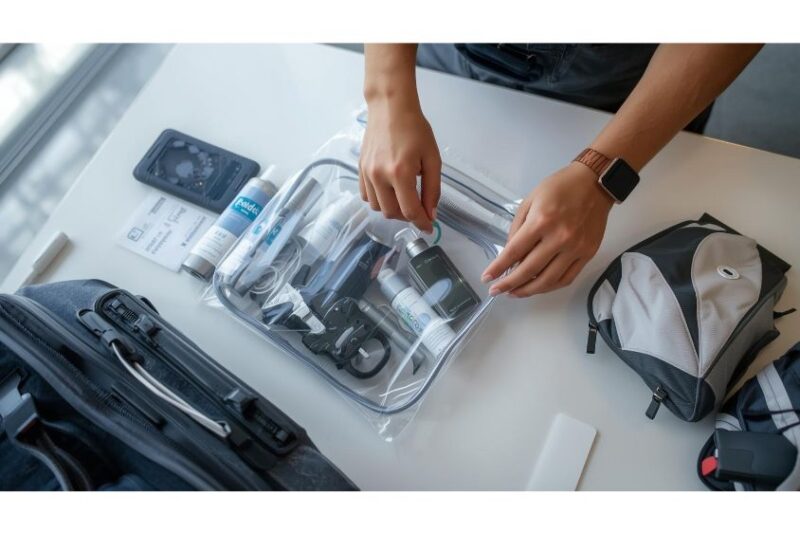Can you bring a vape on a plane? Yes — you can bring a vape or e-cigarette only in your carry-on bag or on your person, not in checked luggage. These devices contain lithium batteries, which the Federal Aviation Administration (FAA) and Transportation Security Administration (TSA) regulate due to fire risk. You also cannot use or charge them on board, ever.
That’s the bottom line. But if you’re wondering how to pack your vape juice, what happens if it’s in your checked bag, or whether airlines treat disposables differently, this guide clears all the smoke.
(Related: Can You Bring a Power Bank on a Plane?)
Key Rules At A Glance
| Item | Carry-On / On Person | Checked BagChecked Bag | Notes |
|---|---|---|---|
| Vape / E-Cig / Juul / Mod | Yes | No | Must be turned off; no charging or use in flight |
| Disposable Vapes | Yes | No | Treated the same as standard vapes |
| Vape Juice / E-Liquid / Pods | Yes ≤ 3.4 oz (100 ml) each | No | Follow the TSA 3-1-1 liquids rule in a quart-size bag |
| Spare Batteries / Cells | Yes | No | Protect terminals or use battery cases |
| Charging Cable / Adapter | Yes | Yes | May carry, but don’t plug in during flight |
Why: Lithium batteries can ignite under certain conditions. That’s why even airline crew aren’t allowed to place these devices in cargo holds, according to official FAA PackSafe guidance.
Can You Bring A Vape On A Plane?

Yes—but carry-on only. When going through security, simply place your vape or e-cig with your electronics. TSA officers see them every day.
Here’s the reasoning:
- Checked luggage: banned for all vape devices because cargo holds aren’t monitored for fire or smoke.
- Carry-on: allowed, as long as the device is off, protected from accidental activation, and not used.
- Gate-check warning: if an agent asks you to gate-check your bag, remove the vape and batteries first and keep them with you.
Vape devices fall under the same lithium-battery rules as power banks and spare phone batteries.
Can You Bring Vape Juice Or Pods?
Yes, but only small bottles that meet the 3-1-1 liquid rule:
- Each container ≤ 3.4 oz (100 ml)
- All containers are inside one clear quart-sized zip bag
- One bag per traveler
To avoid leaks from cabin-pressure changes:
- Leave a little air in bottles (don’t fill to the brim)
- Keep them upright inside a small pouch
- Use a paper towel wrap for extra safety
Vape pods are treated like any other small liquid cartridges—fine in your liquids bag, but not loose in pockets.
Can You Use A Vape On A Plane?
Absolutely not. Using or even charging a vape on board is considered “smoking” under federal law (49 U.S.C. § 41706).
The U.S. Department of Transportation extended this rule to electronic cigarettes, so lighting up your vape—even without smoke—can result in fines or federal charges.
Cabin smoke detectors are sensitive enough to detect vapor mist. Flight crews take this seriously, so don’t risk it. You’ll survive a few hours without clouds.
Airline-Specific Rules (Short & Sweet)
Here’s how major U.S. carriers word their policies (based on official airline pages):
- United Airlines – Carry-on only. Must be off and cannot be used or charged in flight.
- Delta Air Lines – Allowed in carry-on; prohibited in checked. No charging or use on board.
- Alaska Airlines – Treats vapes as “smoking devices”; carry-on only and must remain off throughout the flight.
- Spirit Airlines – Carry-on only; must remove if bag is gate-checked; no use on board.
Across the board, every U.S. airline aligns with FAA guidelines: carry-on yes, checked no, in-flight no.
Can You Bring A Vape If You’re Under 18?
Airlines don’t check your age for vaping devices, but possession laws still apply. In the U.S., the legal age for vaping or tobacco purchases is 21.
If you’re flying domestically, TSA’s focus is on safety, not enforcing tobacco laws. However, arriving in a state or country with stricter rules could get your device confiscated.
When in doubt, check local laws before you pack—or just leave it home if you’re not sure.
What Happens If TSA finds A Vape In Your Checked Luggage?
Most likely, TSA will remove it or flag your bag because lithium batteries are banned in cargo.
You might get a “Notice of Baggage Inspection” explaining the item’s removal. Occasionally, airlines issue a warning at the counter if a device is detected.
It’s not about punishment—it’s purely fire prevention. A short circuit in a pressurized cargo hold can turn serious quickly.
Packing Tips To Avoid Leaky Chaos
Think of this as your 30-second travel checklist:
- Turn off or lock the fire button
- Keep pods and juice ≤ 3.4 oz (100 ml) in a quart bag
- Use a small protective case for batteries
- Partially empty tanks to reduce pressure leaks
- Keep the device in your personal item (in case the carry-on gets gate-checked)
- Never charge or use the vape during the flight
These small details prevent leaks, alarms, or confiscation—and they make your security screening much smoother.
What About International Flights?
Rules for packing are similar worldwide (carry-on only, no use in-flight), but destination laws differ:
- Some countries ban nicotine vapes entirely (e.g., Thailand, Singapore).
- Others allow possession but restrict import quantities.
- Customs may confiscate prohibited devices even if unused.
If flying abroad, always check your destination’s embassy website or the International Civil Aviation Organization (ICAO) guidelines before traveling.
Frequently Asked Questions
Can I Bring Disposable Vapes on a Plane?
Yes—disposables follow the same carry-on-only rule. Keep them off and never use them on board.
Can I Charge My Vape on a Plane?
No. Charging any lithium-powered device during flight is prohibited by most airlines for safety reasons.
Are Vapes Allowed on International Flights?
Usually yes, but local laws differ. Always verify with your airline and the destination country’s customs rules.
What If My Vape Leaks in the Cabin?
Tell a flight attendant right away. Wipe it up and store the device until landing—never try to vape to “test” it.
Can I Carry Extra Coils or Pods?
Yes, as long as they’re clean, sealed, and within your liquids limit if they contain juice.
Final Thoughts
Bringing a vape on a plane is perfectly fine if you pack it smartly and follow the no-use rule. The TSA’s main concern is battery safety, not vaping habits.
So: carry-on only, power off, no charging, no vaping. Stick to that and you’ll breeze through security without raising eyebrows.
If you enjoyed this practical guide, check out our other travel FAQs in the Travel Rules & FAQs Hub—you’ll find clear answers to everyday flying questions like liquids, snacks, and batteries.
